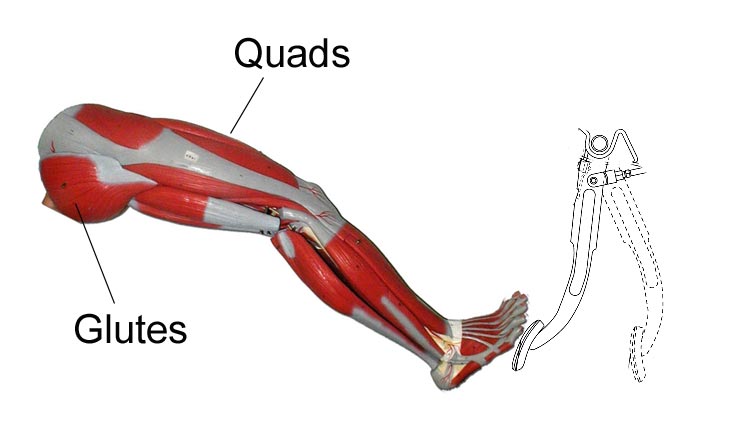

Your leg and the clutch pedal is basically a 4 bar mechanism with a hinge at each joint. The leg provide the motive force to move the clutch pedal.
In the leg, there are two main groups of muscles that can be used to press the clutch pedal, the quads and the glutes. The quads is the muscle that is used to move the lower leg bone (Tibia). The glutes, or the "butt muscle" is used to move the upper leg bone (femur). You can actually control which muscle to use to press the clutch pedal. It is completely up to you. If you don't tell the body which group of muscle to use, then the body will most likely use the one that is the most convinient at the time. If the body picks the quads, you legs will be tired, and you will have knee pain in stop and go traffic.
Why use the glutes instead of the quads? The glutes are one of the strongest muscle in your body. Not only that, but the hip joint that the glutes rotate is a very simple and robust joint. When you are climbing stairs, you are using the glutes. Each step you climb, your glutes is lifting the entire body weight. Let say you weigh 175 lbs. Each step your glutes would have to lift 175 lbs a foot to climb a step. The clutch pedal on the other hand takes probably 20-25 lbs of force for a typical stock car. Your clutch pedal is only about 1/7 the weight of your body. That is nothing. You can quickly see that using the glutes to press the clutch pedal is effortless. Say even if you have to press the clutch once every 10 seconds in traffic, that would be equivalent to lifting 25 lbs every 10 seconds. Remember, the glutes are design to lift 175 lbs (assume that is how much you weight). So how much equivalent work have you done by pressing the clutch once every 10 seconds? It would be like climbin one step of stair every 70 seconds. Therefore, even in heavy traffic, the amount of work your clutch leg is doing is climbing one step of stair about once every minute. Don't know about you, but even a 90 year old person would find it easy to climb one step of stair in one minute. You can keep that up all day long.
What happens when you use the second group of muscle to press the clutch. The quads move the knee. The knee as many people know is a much more delicate joint. It does not have as much area support as the ball and socket hip joint. The knee is where most people have problems. When the quads pulls, it rotates the knees. Just base on plain old physics 101 action and reaction dictates that the load that the quads pulls is the same load that is compressing the knee joint. Unfortunately, the knee has only a thin depth of tissue protecting the joint. With compression of the knee, you are compressing the thin tissue that prevents bone to bone contact. Not only that, base on simple moment arm principles, for you to press a pound of force at the clutch pedal, the compressive force at the knee can be 10 lbs depending on the angle of the knee. The more bent the knee is, the greater the magnification. The 25 lbs of force at the clutch pedal can be a 250 lbs compression at the knee! No wonder the knee hurts after with repeated clutch actuation. On the other hand, when you use the glutes, 25 lbs of clutch pedal force is 25 lbs of compressive force at the knee. It is because you are not using the muscles at the knee to press the clutch. With the glutes, 25 lbs of compression at the knee is nothing compared to just walking around.
By now, hopefully you are convinced to use the glutes instead of the quads to operate the clutch. So how do you make sure you are using the correct muscles. One quick way to check if you are accidentally using the quads is to feel the ligament at the knee. When you are using the quads, you will feel the ligament at the knee tense up. It will be very obvious. Get use to how it feels to use the glutes underneath your legs to operate the clutch. Soon it will become second nature, and clutching becomes completely effortless. I do seriously mean completely effortless even driving 2 hours in stop and go traffic, I don't feel a thing.
